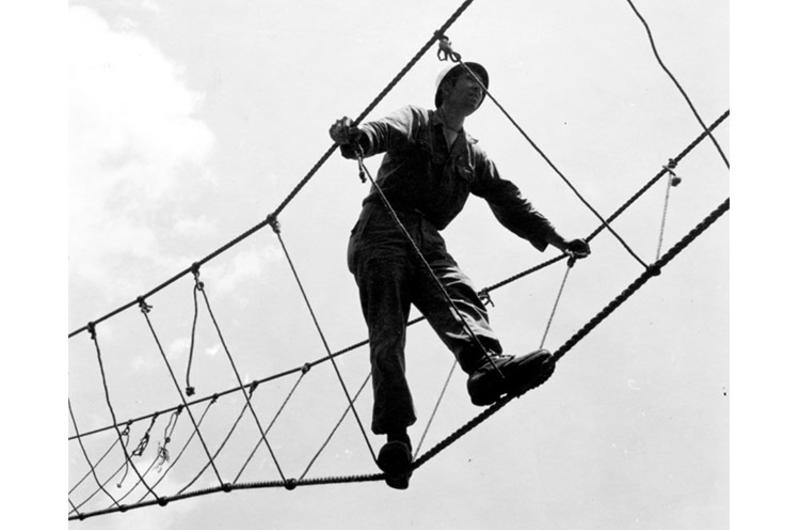Army alpinists

A bit wobbly but easy method of crossing ravines and rivers is this three rope bridge. An instructor shows the proper way of crossing. Students build bridges themselves.
By William J. Colton | Stars and Stripes June 6, 1954
DURING A FOUR-WEEK course at what is probably the toughest school in Japan, men scale cliffs using only finger and toe holds, leap off into space from dizzying heights in practice falls and climb over mountains with full packs in pitch darkness.
Lt. Col. Hazel E. Link, the sinewy commander of the 8147th Army Unit Mountain School, tells new students when they arrive they will be afraid of the mountain and won't want to take the training. "But when you finish the course." he concludes, "we won't be able to keep you off of it."
It's apparently true too. Once they catch mountain fever you can't keep the men from clambering all over cliff faces and overhangs. In fact most of the instructors at the school spend all of their off-duty time, leaves and passes scaling the mountains of Japan.
The student's introduction to mountain climbing techniques comes after he has been issued his special equipment including such items1 as nylon climbing ropes, pitons and a piton hammer, snap links, climbing shoes, a rucksack and sleeping bag. All students and instructors wear helmet liners to keep from being injured by falling rocks.
In a practice area, which features a close to 250-foot high cliff, instructors demonstrate to the students the various things he will learn at the school. While watching the demonstration most of the soldiers look incredulous and joke among themselves to allay their fears.
Shortly after the demonstration they are on the cliff learning balance climbing — climbing without the aid of ropes using only finger- and toe-holds.
Progress is slow and the men hug the cliff face for dear life while the instructors painstakingly point out that they must lean away from the cliff for better balance.
After a few days of climbing the students gain confidence in themselves and manage the climb much more quickly.
THEY LEARN the importance of teamwork, one student often depending on another for his life. From balance climbing the men get into tension and party climbing — climbing with the use of ropes and pitons, a small steel wedge that is driven into cracks of rock.
If one of the men loses his hold and falls into space a partner, wedged into what is called a belay position, holds onto the rope to keep him from falling too far in case a piton gives way. Most of the men agree that the most terrifying sound heard at the school is the "ping" of pitons pulling out during a fall.
When no hand or toe holds are available on a cliff face the men make their way up by tension climbing, driving pitons into the rock cracks, hooking a harness through a snap link that is linked to the piton and inching their way up in a sort of leap frog fashion, the last men picking up the snap links to use when his turn comes to lead the party.
Getting down a cliff is usually much easier and faster. Usually the men rappel, sliding down a rope while making great leaps off the cliff face, their speed controlled by the way the rope is wrapped around their body. After a few tries the students usually prefer rappelling to any other subject taught at the school. Most disliked is balance climbing.
EVEN THOUGH it seems to be the part requiring the most nerve, the climbing of cliffs is just a small segment of the overall instruction offered at the mountain school. Once the student gets confidence in himself, his equipment and his partners he maneuvers up and down cliff faces like a mountain goat.
Fortitude is another habit acquired at the school. A frequent part of the training is walking over the mountain trails with a full pack weighing something like 50 pounds.
In this particular phase of training all agree that the most important thing taught is the "mountain walk," a method of walking up steep inclines so that .the knees lock on each step to take the strain off of weary leg muscles for a brief instant on each step. It looks something like a funeral march in half time but the speed of ascent is surprising. Few breaks are necessary to rest the leg muscles. In fact, the shoulders, straining under the pack, seem to get more tired than the legs.
A few of the other subjects taught are first aid, mountain weather peculiarities, survival, map reading, building two and three rope bridges, suspension traverses and emergency litters and mountain evacuation, including the evacuation of wounded from the top of a mountain.
MOUNTAIN TRAINING is not given to specific Army specialists. Knowledge gained at the school can be utilized by almost all Army personnel. A few more common applications of the training are setting up observation posts, reconnaissance patrols into enemy territory and sniping. In the case of enemy territory a rugged cliff area which a graduate might be assigned to climb would usually be slightly, if at all, guarded. A patrol attack from such a point would carry with it much of the element of surprise.
In addition to the mountain training school a survival course is also taught to flight nurses. According to one of the instructors the nurses often don't even know how to build a fire when they arrive to take the course.
The training is pretty rugged. One nurse said that it was "the first time in my life I ever felt like a pack horse." Most of the training period is spent in the field where they learn to. build improvised shelters, trap food, build fires and even cook. With the exception of rappelling and balance climbing the course is pretty much the same as that taught to boy scouts. In spite of the ruggedness the nurses are emphatic in their praise of the training.
Concerning praise, students at both schools have heaped it on the caliber of the instructors at the schools. Comments range from "great school" to "good instruction." One student summed it all up when he stated that the instructors were serious about their work and didn't fool around; that they were conscientious and take an individual interest in their students, important since the student's life is often in danger.
In spite of the constant dangers faced by the student during the course no one has been killed and there have been very few injuries, most of them minor, and usually caused when the student did not follow instructions. Safety precautions are utilized as much as possible, in fact much more so than usually applied by the average mountain climbers.
Happiest moment comes when the men sing a song, "Altitude Blues," written by one of the students about the training and graduation "exercise" — climbing over 4,600-foot Mount Soma under full pack at night. "When you get on top," the final line goes, "just sit down and gloat. Praise the Lord, you're a mountain goat."



